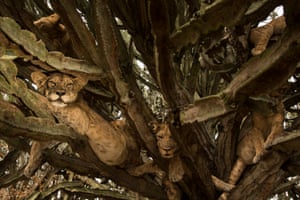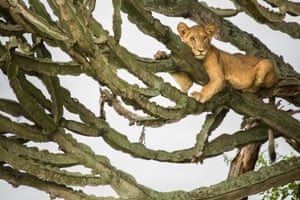From widescreen high-definition wildlife documentaries to food brands, royal crests, sporting teams and Disney movies, the lion is one of the most appropriated and revered animals on the planet.
But this reverence sits in contrast to the falling numbers of the living, breathing muscular cats in Africa.

-
Lionesses Jessica and Julia in a large sycamore fig tree in the Ishasha sector of western Uganda.
In recent years, scientists have discovered a major problem underpinning efforts to conserve the big cat. Some are arguing that almost all the estimates of how many African lions are left, and where they are, could be wildly wrong.
“We are just fundamentally not counting them properly,” says Alexander Braczkowski, a researcher based at the Resilient Conservation Laboratory at Griffith University in Queensland, Australia.

-
Alexander Braczkowski, a Griffith University researcher working on ways to monitor African lion numbers.
Braczkowski is among a group of researchers refining a new method of understanding not just how many African lions there are, but how they move, where they might be thriving and – ultimately – how to spend the millions of dollars each year that go towards their conservation.
Braczkowski put the method to the test during a year spent monitoring and filming lions in the Queen Elizabeth conservation area in Uganda, as part of research at the University of Queensland.
Braczkowski found the area’s lions were in a precarious state, with the home ranges of males much larger than previously estimated – suggesting they were having to travel further to find food.

-
A young lion cub trips a camera trap while feeding on a waterbuck on the Kasenyi Plains, Queen Elizabeth national park.
“The way these animals move is telling you how well they’re doing,” he says. “Small home ranges equals a lot of food.”
Dr Arjun Gopalaswamy, a co-author of work with Braczkowski and science adviser to the Wildlife Conservation Society’s global programs, says this is a concerning trend, because larger home range sizes in big cats are usually associated with reduced density.
“There’s great value in using methods that keep track of lion populations directly and we urge conservation and research communities to cease using ad hoc, indirect methods and shift to more reliable and direct methods,” he says.
Braczkowski says he and colleagues have discovered that two established methods to count lions dominate most of published conservation studies.
One involves searching for lion tracks on the ground and then extrapolating the findings to much wider areas using an equation developed decades ago.
But Braczkowski says this method doesn’t account for the fact that lion numbers could be much more dense in some habitats than others, or the difficulty in counting tracks in places where they do not leave footprints.

-
A large male lion yawns while on a territorial patrol.
Another method is known as a “call-up survey” where observers go out at night with a large speaker and play distress calls of prey animals, then count the lions as they emerge from the darkness, hoping for an easy meal. But this runs the risk of counting the same animal twice – or of some animals not responding to the sounds.
These methods, says Braczkowski, are “simply not reliable enough to understand how lion populations are doing over time”.

-
A lion in a Euphorbia candelabra tree, one of the most poisonous trees in Africa.
The current estimates for lions across Africa suggest there are between 20,000 and 30,000 animals, spread among 102 populations across about 2.5m sq km.
Numbers are known to be declining, but by how much, and where, is the subject of intense debate and great uncertainty.
Even so, Braczkowski, who grew up in South Africa, says their numbers have likely dropped by half since 1994, “coincidentally the same year Disney’s The Lion King was released”.
Braczkowski’s work is part of a method known as “spatial capture recapture statistics” that has been widely used to understand the conservation concerns for other big cats, but has almost never been used to examine the health of African lion populations.

-
Lions wedge themselves in a Euphorbia candelabrum.
In a review of studies into African lion numbers, Braczkowski and colleagues argued the overuse of methods such as call-up surveys and track counting could be having a disastrous effect on lion conservation efforts.
“This could have catastrophic consequences since underestimating lion numbers might cause us to triage an otherwise viable population, while overestimating density might cause under-investment in a population that requires active management,” they wrote.
“Furthermore, non-robust methods can often produce spurious trends in lion population dynamics, which can further mislead conservation investments.”
In Uganda, Braczkowski used a different approach.
Between November 2017 and February 2018 , he spent 90 days in a vehicle with a GPS logger armed with high-resolution cameras and video equipment. Covering 8,250km, he and colleagues counted and photographed lions.

-
A lioness lounging in the afternoon light.
In this part of Africa, the lions have an unusual habit of spending the daytime in trees.
Braczkowski used this daylight opportunity to photograph the lions’ “whisker pattern” – the places on the face where the whiskers emerge from the fur in a pattern that is unique to each cat.
“We used the cinematic cameras to zoom in on the lion’s face but, actually, most cameras can do this,” he says.
Using this method, observers can be more confident they are not counting the same animal twice.

-
A lion cub resting in the branches of a tree.
As well as providing a detailed record of each observed lion, the method also has the bonus of amassing hundreds of stunning close-ups of the animals.
Braczkowski and colleagues hope this approach could be used more widely across Africa. He says it has already been rolled out systematically by the Kenyan government.
“There’s a growth of emerging studies now showing there’s a better way. We’ve got the technology and the cameras and the science. We need to start using it.”